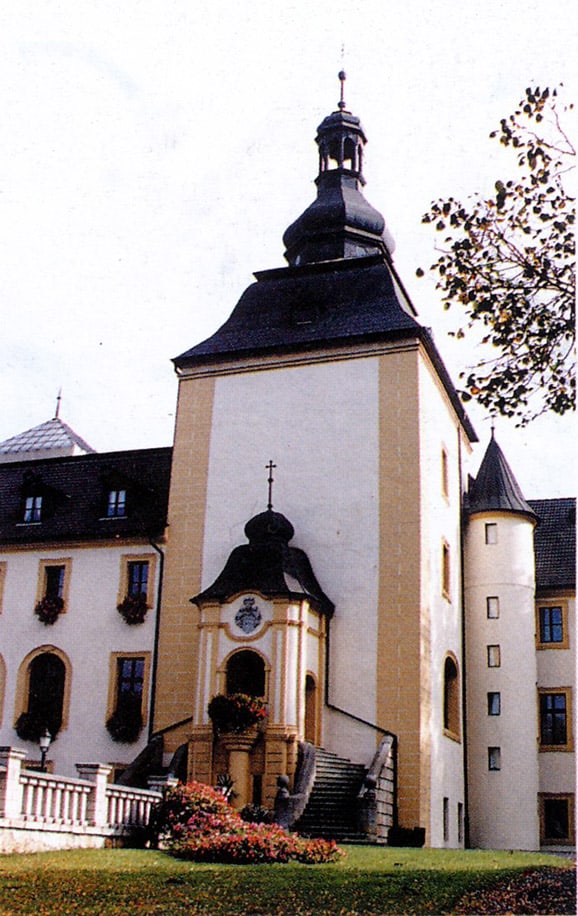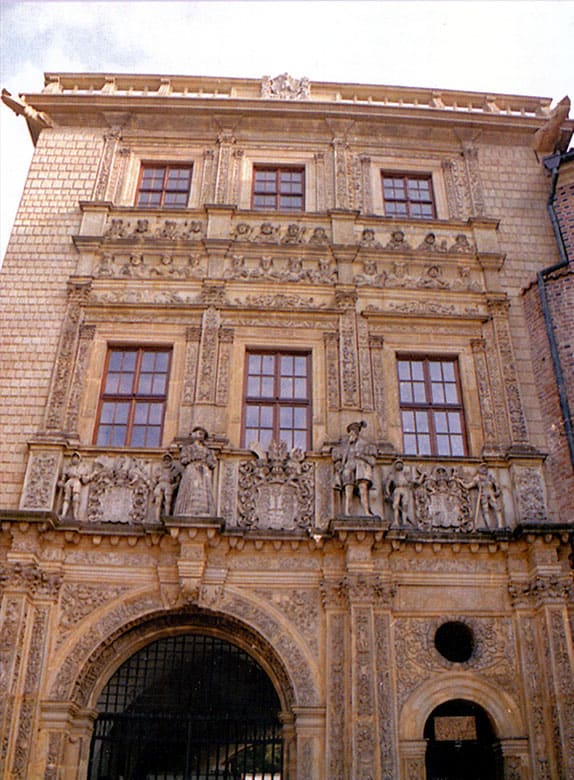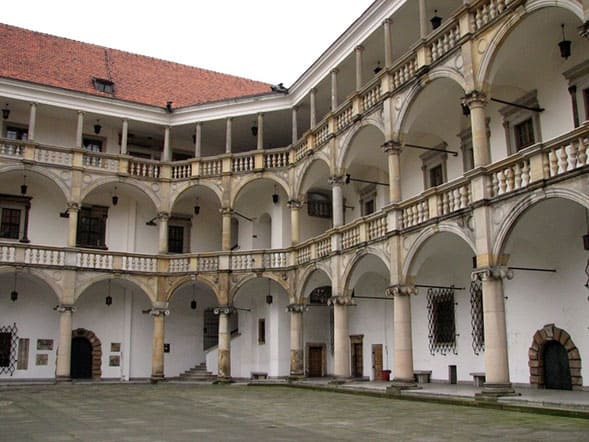
Nearly all the Poles know that the words above are the quotation of „For descendant” poem by Cyprian Kamil Norwid, one of the most famous Polish poets of Romanticism Age, who died alone and fargoten in Paris shelter in 1883.
The entire poem, and especially its final stanza quoted above , express the climate of publication: The present day of Opole Silesia region castles „ The past was a bit earlier today…”.
There are many , many more such objects in the region. The past days all of them are equally interesting , but not all have a special present story. Same of the castles have been turning into a ruin for centuries, Its reconstruction proved to be unfeasible in respect of both human effort and financial assets. Today, those jagged pearls , with their terrifying look, are wating for the new Golden Age. Unfortunately the destruction of them progresses day by day.
However four castles in Opole region : in Brzeg, Moszna, Kamien Slaski and Rogow Opolski, are alive, original treasures today. These are not only architectual monuments , but also results of the great financial and organisational effort that Norwid’s „descendants” have put to bring back their splendour. What is particulary impotrant , thej have introduced the present into the beatiful, ancient interiors. The present , thanks to the people who shape it in this scenery, splendidly harmonises with the past and heads … for future.
Krystyna Raczyńska
The castle in Brzeg
CITIES AND CASTELS OF SILESIA PIASTS
A document dated 850, called bawarian Geographer states that Opolanie tribe possessed 20 cities( civitas), 5 more than Ślężanie tribe. Thad leads to a stunning discovery, that Silesia had a network of cities, protected by fortified buildings rather from southern neighbours than from western, over 100 years before Polish state was established. Gall Anonim chronicles confirm that fact.
Castels were build in Siesia after Polish state was constituted, but much erlier than in other part of country.
The first stage of castles’ development took place -according to historians – between 1230 and 1320. This period was opened by the start of construction of the Legnica castle in Lower Silesia by Henryk Brodaty.
Although historical treminology defines cities, castles and palaces, it is imposible to seperate the castles’ construction periot from cities’ construction period since the differences betwee castles and cities are rather slight.
The oldest state casles, royal and prince’s ones, were built in Silesia and Mazovia.
Accordong to royal privileges ( so calld regalia) only the king was entitled to build and posses fortified castles. Other secular and church feudal lords could build and posses such castles only with king’s permission.
We know for example that because the construction of the castle in Opole in 1228 exeeded the financial resources of prince Kazimierz I , the half of the investment cost ( 500 grzywna) was covered by Opole governor Klemens and his brother Wierzbięta. It is also known that in Silesia , in regionall separation periot, middle -class castels appeared, together with earlier built peasant’s strongholds protecting the citizens from the Chech robbers.
The basic and the main castle function was defence. The castle was fortress. In Opole region 7 oldest castles were built along Odra River. These are: castellan caste in Koźle, knight castle in )tmęt, prince castle in Opole. On the left side of Odra castles in Głogówek and Chrzelice and on the right side of the river in Strzelce Opolskie and Kamień Polskie are the earliest one.
The distance between the castles did not exeed 20 kiometers. The castles were fortifying Polish southern border.
We have to remember , while evalueting the role of castles , that they were not only defence strongholds, but also comfortable huses of feudal lords and their families. They were also safe bases, protecting life and property of inhibitantsknights servants and journeyman and borough inhabitants, who were hiding in the castle in the case of danger. At the end of the Middle Ages castles aslo presentable role.
They were the centres of life, with the central building, houses, and farm buildings, a tower, gate donjon, chapel and other objects grouped together. The functioning of the castle required work of a large group of people: administrators , economists, craftsman, and peasants, since the estate was the base of existance.
In Opole- Silesia castles were built beginning from the Piast era. Silesia Piasts, though often divided, were very good landlords. Small Silesia duchies were blooming these days. Cities like Legnica , Brzeg, Oleśnica and others were architectual masterpieces. Great Piast castles, for example in Brzeg, Glogowek, Niemodlin and magnificent temples prove it.
The memories of good times are also connected with Piasts. The people believed that Piast knights, known as Saint Jadwiga army, who rest in peace in Ślężaand in the basement of Trzebnica monastery, will wake up one day , attach Silesia to Poland and bring good old times back.
The prist Konstanty Damrot in his poem „ Piast tower in Silesia”prised the meaning of Silesia Pists’ work: „temples were their piety monuments, and the signs of great spirit were engravedon towers, that protected their cities with charm…”.
His poem beginnig with :
„ All our Piasts have died,
The fame of their acts fell into oblivion,
Sstrangers aquired their land,
And emptiness gnaws at proud castles”
and ending with hope:
„Old donjons not only remind,
The Golden Century moments,
But also do not let the hope fade,
That Piasts’ emblem will shine on the towers,
Freedom sunset light will embrace Silesia,
When White Eagle spreads his wings,
And there will be one shepherd and one swine”
herald the idea of the united Europe of the beginning of the XXI century?
SILESIA WAWEL AT ODRA
The castle in Brzeg lies in north -western part of the city, where earlier a wooden prince manor was located. The manor was replaced by Gothic -styled stone buiding, where Bolesław III , the first in Brzesko – Legnica dynasty, lived. Under the prince Ludwik I the castle was throughly rebulit. Today we can see quite huge elements of Gothic castle behind southern wing walls and lower stocks of a mighty „lions” tower, a massive building that could have been designed for ultimate defence actions.
Some rebulding works in Brzeg castle took place also in XV century. They have however reached the greatest extent in XVI century and were aimed at reconstructing the castle up to the Renaissance architecture guidelines. Tis great, over 50-year-long rebuilding, was started by prince Fryderyk II in 1530. The southern wing , on the city side and than the eastern one, on Odra riverside, gate breaks and the part of sculptural elements were compleded during his reign. Geothic elements such as Saint Jadwiga church ( a patron saint of Silesia Piasts) were blended into the new Renaissance structures.
Castle in Brzeg
The most important period in Brzeg castle history was the 50’s of the XVI century. Between 1547 and 1560 Brzeg- Legnica dynast prince Jerzy II completed much wider – in comparison to his father’s Fryderyk II one- rebuilding plan. The prince entrusted rebuilding works to artists and architects from northern Italy, called Komask. The castle was design on the model of Krakow castle- Wawel, which Renaissance beauty captivated the people than. Jakub Parr was the manager if rebuilding . His son Franciszek and brother – in p law Bernard Niuron assisted him.
The original appearance of Renaissance prince residance in Brzeg can be reconstructed on the basis of its existing original elements and detailed descriptions and drowings from the XVII and XVIII century. The castle had than a shape of almost regural square around arcade courtyard. Three main wings had four storeys and the highest was distnguished by decorative dormer windows tops. Only northern wing was designed in different way and was probably one storey high building with open -work cloisters.
The entrance to the castle from courtyard was closed with sharp gate arch.
The gate was decorated with sculptures resembling laurels, the other sculpture part are ancient armament elements ( panoplia) and two coats of arms: prince Jerzy II and his wife Barbara one.
The courtyard is an magnificent as the gate facade. In Piast ages three or two-storey cloisters, with marvellous sculptures and paintings on the outside walls, surrounded it. All the inside courtyard windows had wide, stone, sculptured, perfectlymade frames of interesting design. Cobblestones floor completed the stunning beauty of the courtyard. Thanks to cloisters, design and equipment of the chambers, which was as rich as artistic and utilitarian collection in Krakow- the former Polish capital, Brzesko castle gained the name of Silesia Wawel.
Unfortunately the time has not been favourable to the Brzesko- Legnica Piast dynasty residance. After the death of the last of Piasts the castle became a seat of Austrian Habsburg dynasty administration. In 1741, during the siege of Prussian army the castle was ruined by cannon fire. The courtyard arcades were destroyed than . Later, Fryderyk II , Prussian king. Located his army storerooms here. The following fires and acts of vandalism completely destroyed the castle.
The first attempt at rescuing the castle took place at the end of the XIX century, but the results were rather poor. Only beteen 1925 and 1926 the existing storerooms were closed and the interioirs donated to a new museum. Unsuccessful preparations to restore the castle were undertaken between 1935 and 1944.
Second World War caused serious damages to the city. The castle suffered from it as well. The existing parts of cloisters were almost totally destroyed. Ancient interiors became ruined, apart from ground floor of eastern wing with stuccoed vaults and precious polichromy with Brzeg-Legnica dynasty family tree. Devastated building was secured and sllightly renewed after War but until the 50’s no decision on reconstructing was made. The preliminary procject of rebuilding the castle was prepared in 1963 and the work begun three yars later.
Long lasting reconstruction brought gradually the fines look of Piasts residence of its best ages back. Rebuilding of castle was complited and the arcade courtyard reconstructed. Careful finishing touches were put to the interiors. Since the icon material was lacking the northern wing was not reconstructed. A curtain wall was builed instead. Stone courdyard floor was made of sandstone. At eastern wing, where the garden is falling towards Odra river, the Renaissance decorative garden , with a typical for Renaissance labyrinth, boxes, Alpine currant bushes and climbers, was reconstructed. It is worth pointing out there are only a couple of such garden in Poland.
Southern wing and adjoining terrain was shaped adequately. A pergola with hanging climbers, design on the model of XVII century one -floor arcade galery was build along the front elevation of this wing. It enlivens the entire facade of the wing. Square -shaped flowerbets and lawns, toghether with a decorative sandstone well, are llocated behind a low stonewall surrounding the terrain.
Piast castle is an evidance of Polish care for their cultural and historical heritage. The castle, after a long renovation, belongs to most magnificent architectual monuments not only in Opole – Silesia and Poland, but also in Europe. Whats is more, the Museum of Polish Piasts that is located there is the only Polish research institution studying Piast dynasty history, their political, economic, educational, social, cultural and patronage activity.
Thausands of turists and different Polish and regional cultural events participants visit castle each year. And there is much to see there, since regural and priodic expositions are located on ground floor. Extremly interesting archaeoogical collection, with the example Middle Ages, unique in Europe, wooden hunter bow, sculptures and furniture of different ages, precious and beautiful Gdańsk warderobes and Renassance mother of pearl incrusted furniture, valuavle paintings (of for example Italian artist Givanni Pinotti), armament, hand-made artistic works, numismatics objects and city history related exibits are presented besides the momentoes of the ancient owners. Attention should be paid to Piast psam books and documents, zinc vessels and china collections.
Huge model of of the XVII century Brzeg attracts many tourists, as well as the exibition devoted to ancient Silesia art between the XV and the XVIII century. This exibition is a result of co-operation with National Museum in Wrocław.
The exibits will be displayed in Brzeg for a few years, until the renovation of Franciscan church at Nankier Square is completed.
Brzeg museum is not only a great memento of our past. It is also active in a present life of the city and of the region. Naational and regional ceremonies, scientific sessions and meetings, lectures and concerts are organised inside the castle and in the gardens. A few dozen concerts are taking place here each year, also within international events such as Vratislavia Cantas festival. International Festival of Vienna Music or Poets Invasion on Silesia Piasts Castle in Brzeg.
The text is based on the articles of professor doctor Franciszek Marek and doctor Jan Majewski
Towarzystwo Wiedzy Powszechnej, Opole 2001.



